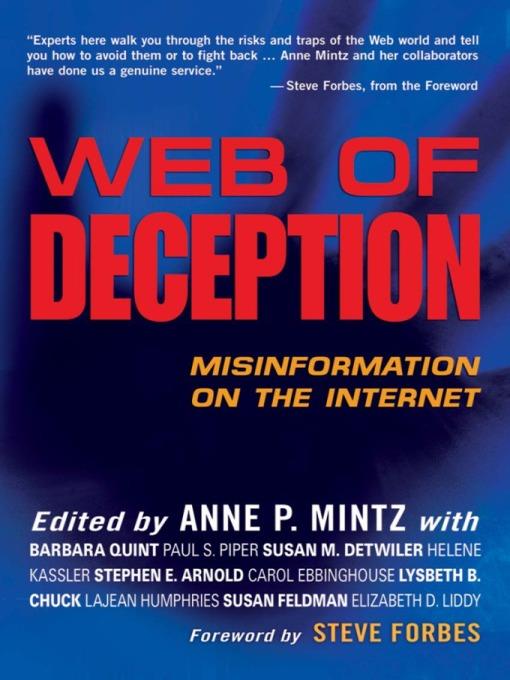
Web of Deception
Misinformation on the Internet
کتاب های مرتبط
- اطلاعات
- نقد و بررسی
- دیدگاه کاربران
نقد و بررسی

September 1, 2002
There's a vast amount of intentionally misleading and erroneous information on the Web, says Anne P. Mintz, the director of knowledge management at Forbes Inc. To help readers recognize and deal with this problem, she has gathered 10 contributors to write Web of Deception: Misinformation on the Internet. The authors-who range from database experts to consultants to librarians-examine various pitfalls casual Internet users and professionals should watch out for. The subjects include e-commerce fraud, Web sites that "play doctor," identity theft, charity scams and more. One of the book's most revealing chapters is librarian LaJean Humphries's explanation of how to evaluate a Web site. She suggests considering who wrote the site's content, how often it is updated and if the document is well written. A "webliography" lists sites that offer quality information (among them, www.fraud.org and www.charitablechoices.org). Mintz's wise book will be of great help to parents, educators and every Internet surfer.

January 1, 2003
Adult/High School-The 10 information-industry professionals who contributed essays to this book were commissioned to share their expertise in illuminating and analyzing the "dark side" of the Web. They aim to impart critical-awareness skills, a healthy dose of skepticism, and practical tips to Internet users. By coaching consumers to engage proactively in investigative search techniques, they want to educate an online community that will be less likely to fall prey to hoaxes, charitable scams, identity theft, medical or legal misinformation, and fraudulent e-commerce schemes. Chapters on how to evaluate Web sites and on how search engines work will be particularly valuable to students, arming them with checklists for establishing authority, strengthening their ability to discern bias, and alerting them to considerations of "paid placement" and subtle advertising in ranked search results. Each topic is thoughtfully addressed, documented with excellent examples, and, in some cases, accompanied by remedies or "countermeasures" to pursue to redress a grievance. An extensive index and a Webliography of quality sites mentioned in the text (many representing links to key government and nonprofit resources) round out the book. The multiple authorship of the text causes the writing to be a bit uneven; some chapters are readily accessible to casual readers, while others target a more sophisticated audience. Nevertheless, the book represents a welcome addition to the arsenal of tools offering guidance on identifying trustworthy, accurate data on the Web, and provides a public service by enumerating techniques for spotting misrepresentations.-Lynn Nutwell, Fairfax City Regional Library, VA
Copyright 2003 School Library Journal, LLC Used with permission.

August 12, 2002
Edited by the director of knowledge management at Forbes Inc., this collection of essays on the use of the Internet to deceive intentionally brings together the experience of both information industry professionals and librarians in order to shed light on the darker corners of the Internet. Contributers include Mintz, Paul Piper, Susan Detwiler, Stephen Arnold, and Susan Feldman. Certainly deception and antisocial behavior (and gullible victims) preexisted long before the Internet; however, the electronic realm has proved to be a fertile playground for thieves, charlatans, and propagandists. The types of intentionally deceptive Internet activity covered include counterfeit web sites and web hoaxes, medical misinformation, corporate misinformation, identity theft, privacy invasion/data mining, charity scams, consumer fraud, questionable legal advice, and search engine/ad placement issues. Examples of intentional deception range from the hilarious to the potentially deadly. Other chapters provide information on evaluating web sites and using search engines and what to do if you are a victim of fraud. Short of unplugging from the Internet completely, there are ways to protect and advise library patrons who use the net, and this book provides detailed information, countermeasures, and useful web sites. It would be difficult for any print book to be up-to-date on the creatively devious ways that online users can be exploited on a daily basis. However, the remedies offered are still current and broad enough to be useful. Although data mining is discussed, a chapter on adware, or so-called "spyware," would be helpful in any future edition. Recommended for public, school, and academic librarians, especially those who teach information literacy workshops. [Index not seen.] Robert L. Battenfeld, Long Island Univ.-Southampton Coll. Lib., NY
Copyright 2002 Library Journal, LLC Used with permission.

























دیدگاه کاربران